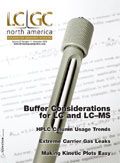Taking the Industry's Pulse After a Challenging 2009
LCGC North America
It seems hard to believe that we are already nearing the holidays and the end of 2009. And for many in the world of separation science, after weathering difficult economic conditions, solvent shortages, and more, welcoming in 2010 will be something to look forward to indeed.
It seems hard to believe that we are already nearing the holidays and the end of 2009. And for many in the world of separation science, after weathering difficult economic conditions, solvent shortages, and more, welcoming in 2010 will be something to look forward to indeed. However, the end of the year can also provide us with a unique perspective and a chance to take stock of the marketplace, and at LCGC, we have done just that.

David Walsh
This month, LCGC presents the results of our most recent HPLC User Survey in Ron Majors' November installment of "Column Watch." In such an eventful year, the results of this survey are more informative — and intriguing — than ever before. For now, we finally have hard data to answer many lingering questions that to this point have been answered largely by consulting popular wisdom and word-of-mouth. Have changes in thinking toward solvent usage changed the overall HPLC market? Which techniques have taken off under these market conditions and which have seen decreases, and most importantly, why? Which column types are being used more than ever, and which types have fallen in popularity? Ron's column answers these questions and more, giving readers their clearest picture yet of where the market stands after the rollercoaster of a year that was 2009.
As always, LCGC strives to bring you the nuts-and-bolts information from the front lines of the separations laboratory, and the 2009 HPLC User Survey is just another example of this commitment. The results presented in this survey come not from revenue projections or informal discussions, rather, they come from having direct interaction with the users performing chromatographic research every day, and we believe this makes them all the more relevant and reliable.
We hope you find this survey and the rest of the industry-leading columns and technical articles in this issue useful, and as usual, feel free to contact us with any comments you may have.
Enjoy the issue.
New Method Explored for the Detection of CECs in Crops Irrigated with Contaminated Water
April 30th 2025This new study presents a validated QuEChERS–LC-MS/MS method for detecting eight persistent, mobile, and toxic substances in escarole, tomatoes, and tomato leaves irrigated with contaminated water.

.png&w=3840&q=75)

.png&w=3840&q=75)



.png&w=3840&q=75)



.png&w=3840&q=75)











